inGOV
Enabling integrated public services with AI/ML powered chatbot
In a strategic collaboration with the City of Bjelovar and the broader inGOV consortium, Point Jupiter led the development and deployment of an AI-driven mobile virtual assistant. Leveraging advanced machine learning and natural language processing technologies, the project sought to bridge the information gap between citizens and public services. The outcome: an intuitive and responsive platform that not only facilitates smoother interactions but also fosters a sense of community involvement and trust in local governance.
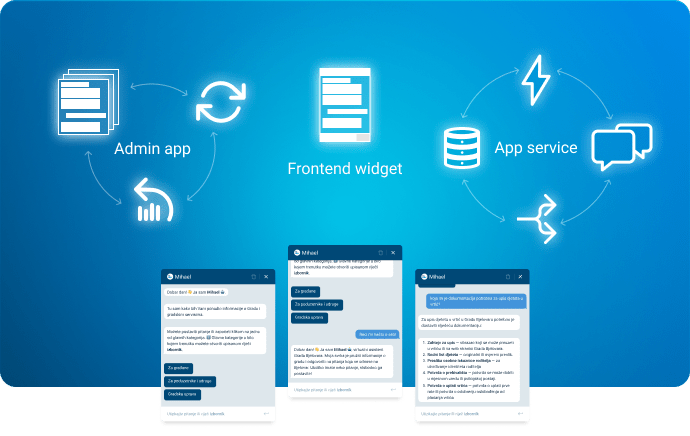
Point Jupiter collaborated with the City of Bjelovar to create a specialized AI-driven chatbot, a public services virtual assistant. The project streamlines citizen access to public services and sets a new standard for civic engagement.
Services utilized
AI & machine learning development
- Custom chatbot architecture
- Natural language processing (NLP) for Croatian language
- ML and language models and third-party integrations
Custom software development
- Frontend chat widget in React for user interactions
- Backend development for the app service stack
- Admin app development for conversation review and response data updates
UX and UI design
- UI and UX design for the chatbot widget
- Admin app interfaceUX and UI
- User research, workshops and strategy
System Architecture
- System design
- DevOps
- CI/CD pipelines
- Model training and updates infrastructure
QA and Testing
- Manual testing
- Continuous QA
- Conversation reviews
About the project

The inGOV project was conceptualized with the vision to revolutionize public services for European citizens, aligning them with the advancements of the digital age. Understanding the gap in seamless digital public service provisions, inGOV sought to design an encompassing holistic framework for Integrated Public Services (IPS). This would not only modernize how citizens access public services but also ensure that these services are more interactive, inclusive, and intuitive.
The framework’s breadth was immense – it spanned mobile tools, advanced digital architectures, and incorporated principles of co-creation, ensuring public services were designed for the people, by the people.
A hallmark of the inGOV project was its practical approach to innovation. Rather than being purely theoretical, the project was grounded in real-world application via its four pilot implementations.
The City of Bjelovar in Croatia was selected as one of the pilot locations to test and implement the capabilities of the AI-driven mobile virtual assistant. In this endeavor, Point Jupiter collaborated closely with local authorities to create and fine-tune the technology and tailor it to the specific needs and characteristics of the community.
This virtual assistant is designed to handle a wide range of frequently asked questions from citizens. From information about scholarships to the protocols for getting a building permit, the assistant serves as a reliable first point of contact. Its aim is to make public service information easily accessible, thereby alleviating the workload on city employees who can then focus on more complex, case-specific issues that require human intervention.
But the assistant is more than just a query handler; it’s a dynamic tool that can evolve over time. As the system collects more data and feedback from users, it can learn and adapt, improving its accuracy and utility. The technology is built to be robust yet flexible, capable of integrating future services and utilities as the needs of the city change.
Overall, the AI assistant will not just provide answers; it will offer a new, more efficient mode of interaction between Bjelovar’s citizens and their local government, setting a new standard for what public service can be.
3.28M euros
total project value
7 EU countries
involved in project
13
consortium members
4 pilot projects
Austria, Croatia, Greece and Malta
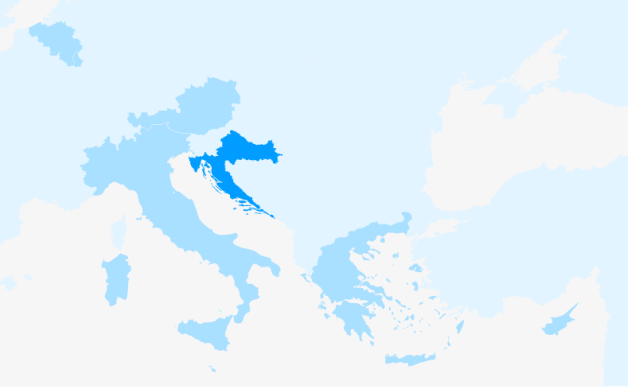
On a broader scale, the entire inGOV project had three main objectives divided into following groups:
Scientific and innovation objectives
These centered around understanding the current state of IPS in Europe, understanding stakeholder needs, and creating innovative co-creation models.
Business objectives
These objectives aimed at providing clear guidelines and recommendations for IPS Governance, stakeholder agreements, and more. It also emphasized the need for widespread awareness and application of the inGOV roadmap and methodologies.
Technical objective
Here, the focus was on designing a reference architecture blueprint and an ICT platform to support new IPS governance models.
Challenges
The journey of revolutionizing public services, as embarked upon by the inGOV project, was not without its obstacles. Several challenges were unique to the context of the City of Bjelovar, Croatia, but were indicative of broader issues faced by numerous cities across Europe. Let’s take a deep dive into these challenges.
Aging population with unique digital needs
Bjelovar boasts a rich history and with that comes an elderly population who have seen the world evolve in myriad ways. Their experiences, while vast, don’t necessarily include a deep understanding of the rapid digital changes occurring in today’s world. Many of these citizens possess lower computer literacy levels. They often lean on the convenience of mobile phones instead of traditional computers. This transition from the old to the new and designing services tailored for their comfort became a paramount challenge.

Disparate public services
Every city has its unique way of operating, and in Bjelovar, the digital infrastructure for public services was fragmented. From participatory budgeting to e-forms and issues reporting, each platform had its own look and feel, operating independently of others. This fragmentation was not just a navigational maze for users but also a backend administrative challenge. Citizens often found themselves climbing a steep learning curve every time they switched between these services, a task made even more difficult for those not familiar with digital interfaces.

Low discoverability and awareness
Digital transformation is only successful when its users are aware of it. Despite Bjelovar’s efforts in digitizing a significant chunk of its public services, many of its citizens remained in the dark. This wasn’t because the services weren’t beneficial, but more because they lacked unified marketing, leading to reduced usage.

Resistance to digital transition
Embracing the new can be daunting, especially when it comes to technology. This resistance to digital transition wasn’t exclusive to the users but also echoed in certain administrative sections. The apprehension, often labeled as the “fear of the unknown”, posed a significant hurdle in the effective adoption of the new digital paradigm.

Lack of co-creation and feedback mechanisms
The era where public services were designed with a one-size-fits-all approach has passed. The digital age emphasizes the importance of collaboration, feedback, and co-creation. However, establishing these mechanisms in Bjelovar was a challenge in itself.

Accessibility and inclusivity concerns
For a public service to be truly public, it needs to cater to every citizen, including those with disabilities. Meeting the diverse needs of Bjelovar’s population while ensuring the services were in line with the Web Accessibility Directive was a task that required a delicate balance of innovation and empathy.
Tackling these challenges wasn’t just vital for the City of Bjelovar but served as a blueprint for other cities navigating similar waters. The inGOV project aimed to offer solutions that were both replicable and scalable, setting the tone for a digital future across Europe.

Solution
As part of Point Jupiter’s approach, we always consider two main elements for our solution. The first one deals with our general approach and strategy. We discuss key values, methodological approach and related topics. The other one deals with the actual technical implementation and its nuances.
Let’s go and explore both of these two elements. We will start with the approach and strategy.
Approach and strategy
The inGOV project, while rooted in digital innovation, recognized that its ultimate success lay in addressing real-world challenges faced by the residents of Bjelovar. The city, with its diverse demographic comprising a notable elderly population and its own unique administrative hurdles, demanded a highly customized approach.
Emphasis on co-creation and co-design
The essence of co-creation and co-design became even more pronounced when addressing the particular needs of Bjelovar’s elderly and other targeted groups (general working population, entrepreneurs, and NGOs).
Given that this demographic often feels left behind in rapid digital shifts, the project ensured that their voices were at the forefront. Co-design sessions frequently involved these citizens to validate the intuitive nature of the AI-driven mobile virtual assistant, ensuring that even those with lower levels of computer literacy could engage seamlessly. Through such engagements, the issues of disparate services, lack of awareness, and accessibility challenges, which were rampant in the earlier system, started seeing redressal.

Stakeholder engagements – from citizens to the City administration
The City of Bjelovar’s diverse services, numbering over 114 processes with 88 of them digitized, was both an asset and a challenge. By actively involving city departments, service providers, and administrative bodies, inGOV ensured that the solutions developed were not just theoretically sound but practically implementable.
Beyond the surveys and workshops, the inGOV project’s ground activity in Bjelovar was evident in its participatory approach. For instance, in initiatives like participatory budgeting, the local authorities and citizens collaborated in real-time, strengthening the sense of community ownership and investment in the project’s outcomes.

Needs elicitation
This wasn’t just about generic feedback. Taking into account Bjelovar’s unique challenges, the elicitation process went deep into the complexities of the city’s existing digital offerings. Discovering pain points in services such as e-forms and issue reporting was crucial. This granular feedback was instrumental in fine-tuning the AI-powered virtual assistant, ensuring it addressed specific, localized concerns.

Technical audit and interviews
The intricacies of Bjelovar’s digital infrastructure demanded a thorough technical audit. Given the city’s previous efforts at digitizing numerous public services, understanding the technical foundation was crucial. This audit ensured that the new solutions were not just layered atop but intricately woven into the existing digital fabric of the city.

Post-inGOV and EU funding sustainability
The sustainability of any project after its initial funding is critical. To address this, the project didn’t just stop at the creation of the AI-driven mobile virtual assistant. Emphasis was placed on ensuring the City of Bjelovar had the tools and knowledge to maintain and adapt the system long after the project’s formal conclusion.
Training became a cornerstone of this sustainability strategy. A range of training materials was created, and several workshops were conducted to empower city employees. These sessions, supplemented with recorded videos, provided both theoretical knowledge and practical skills, ensuring even those without a technical background felt confident in their ability to manage and update the system.
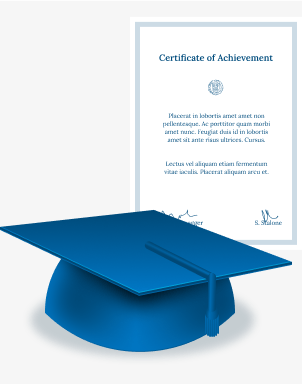
Furthermore, in a strategic move to future-proof the system, Point Jupiter embarked on developing an advanced solution tailored for the city. This solution would allow city employees to continually update the virtual assistant’s database and even retrain the underlying AI models, ensuring the system remains relevant, accurate, and efficient. All of this was designed with an emphasis on usability, ensuring that city staff could perform these tasks without requiring deep technical expertise.

The project’s commitment was to leave behind not just a product but a legacy — a system that would continue to serve the citizens of Bjelovar for years to come, long after the conclusion of inGOV.
Technical implementation
Grounded in insights from our strategic and methodological approach, our technological implementation ensures that all those starting points and project’s overall goals are turned into reality.
The following section details our technical approach. From the general system architecture overview through our NLU pipeline – we will show you how we implemented our solution.
Tripartite system architecture: Foundations for interaction
The virtual assistant’s technical backbone can be visualized as a three-pronged or tripartite architecture, each prong serving a distinct yet interconnected function:
Frontend chat widget is the user’s gateway to the system. Developed in React, the widget is responsive and versatile, designed to provide users — whether accessing via desktop or mobile — a seamless and familiar conversational experience. Beyond its interactive design, it’s the embodiment of user-centricity, ensuring that every question, concern, or feedback is efficiently processed.
One of its noted advantages is the fact that it is easy to incorporate into any other website or different channels. This way, we are able to bring intuitive and seamless user experiences across different platforms.
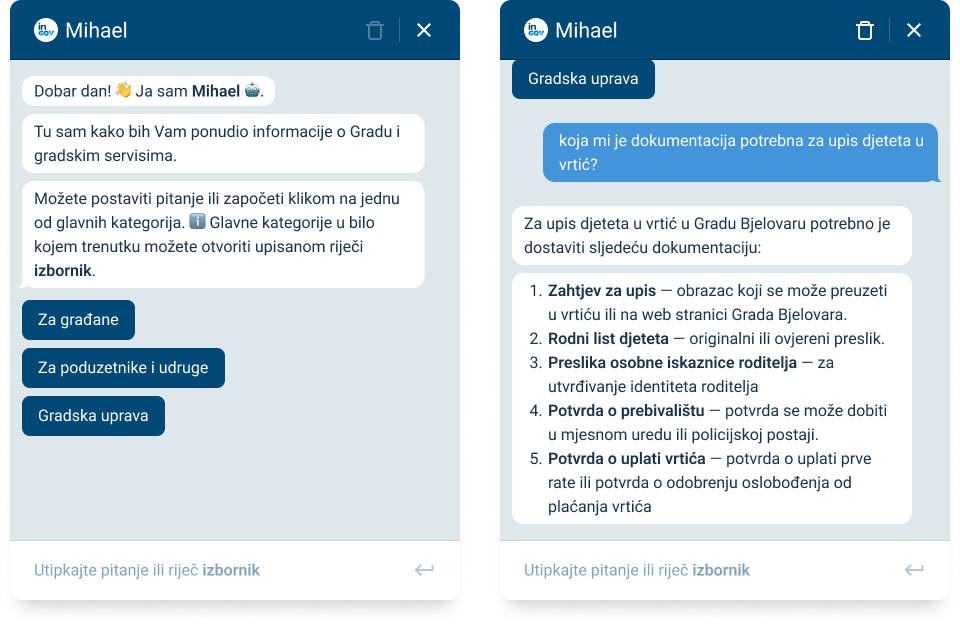
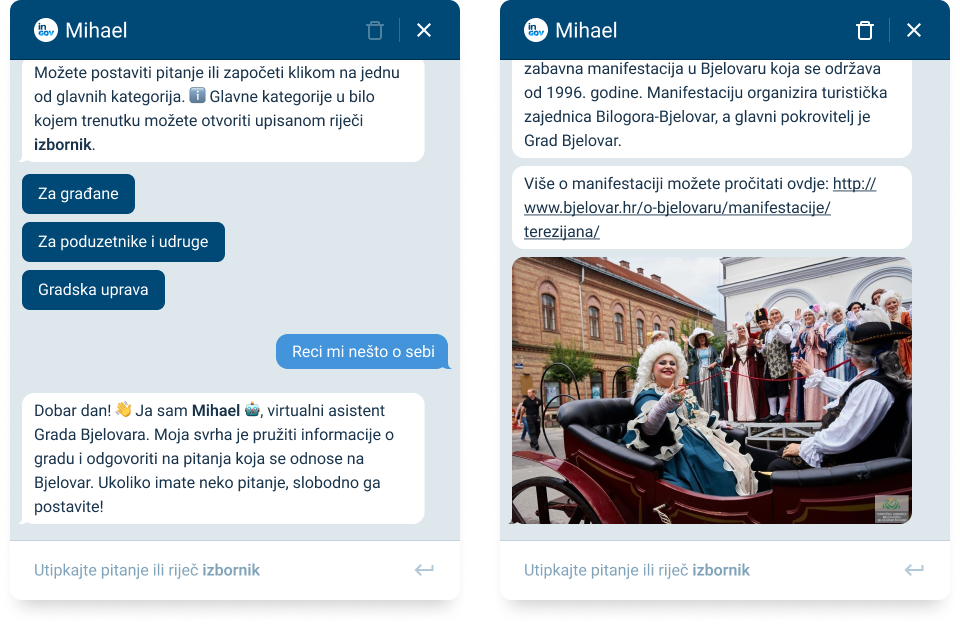
Often likened to the ‘heart and brain’ of the system, the App service is where the magic truly happens. Comprising an amalgam of web servers, databases, and advanced AI components such as text classifiers and generators, it powers the system’s core functionalities.
Behind the scenes, the Admin application acts as the observatory and control center. It allows administrators to review, analyze, and understand user interactions in real-time. More than a mere monitoring tool, it’s a feedback loop, enabling iterative improvements by capturing areas of success and potential enhancements.
Together, these three components form a holistic, robust, and adaptable architecture, tailored to meet the unique needs of the City of Bjelovar, yet scalable and flexible enough for future expansions and integrations.

Tailored NLU pipeline and Croatian linguistics
Croatian, a beautiful Slavic language rich in nuance, posed unique challenges.
Our tokenizer, pretrained on a comprehensive Croatian corpus, dissects each message, handling tasks like lemmatization and subsequently attaching part-of-speech (POS) tags to tokens. Distinctions like “da” meaning “yes” and “dani” translating to “days” are essential to the system’s linguistic accuracy.
To enhance the precision, a Regex Entity Extractor chips in, especially for phrases or linguistic structures that might baffle a standard classifier. Working alongside, the entity detection featurizer identifies essential linguistic markers, like the beginning-of-sentence (BOS) and end-of-sentence (EOS).
Advanced classification as the engine’s decision-making core
The tokens, once classified with POS tags, undergo another layer of refinement via the CountVectorizer featurizer.
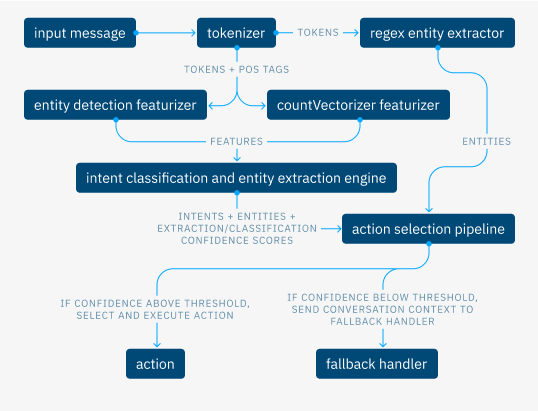
This conversion of messages, intents, and responses into a bag-of-words format is essential for the subsequent classification process. The system’s ML model, specifically pretrained, then takes over, categorizing messages within defined domains while also extracting entities. This robust mechanism ensures that users’ queries are understood in context, leading to more accurate responses.

Dynamic responses and deciding the next move
Our system is like a chess player, always thinking a few moves ahead.
The Action Selection Pipeline, armed with the user’s conversation history, determines the system’s next move. A unique blend of rule-based logic and cutting-edge ML algorithms ensures our AI is proactive, not just reactive.
But there’s a safety net!
Every AI decision undergoes a stringent confidence check. If the system’s certainty wavers, our integration with foundational large language models serves as the fallback. By crafting context-aware prompts, we ensure that the AI’s response remains accurate and helpful, even in ambiguous situations.
Moreover, we actively employ a method called RAG (Retrieval Augmented Generation) to provide domain-specific knowledge and significantly decrease the risk of model hallucinations.

Future-proofing the system
Bjelovar and the Croatian language might be our starting point, but the vision is expansive.
The methodologies, the tech stack, and the underlying AI principles are globally applicable. This chatbot serves as more than just a prototype – it’s production ready solution, demonstrating how AI can be a transformative force within public services.
It beckons governments worldwide to envision a future where AI becomes an indispensable ally in efficient public service delivery.
Team and collaborative dynamics
Working as a part of an expansive consortium comprising 13 partners from 7 different EU countries presented a unique set of challenges and opportunities. This consortium spanned a spectrum of contributors, from academia to industry leaders, and even local and regional governments. Navigating this diverse landscape required finesse, adaptability, and a commitment to clear communication.
Despite the varied backgrounds and perspectives, our team seamlessly integrated, collaboratively addressing challenges, and leveraging the wealth of expertise at our disposal.
While every partner brought a unique set of skills and knowledge, our cohesive approach and shared vision ensured we not only adjusted to the diverse environment but also crafted a solution that beautifully met the objectives of the inGOV project.
Now, meet the team!
 EU Project and Product Manager
EU Project and Product Manager
Our EU PM ensured the alignment of our efforts with the broader objectives of the inGOV initiative. His responsibilities included complete product design and development coordination and ownership, compliance oversight, milestone tracking, and coordination with EU representatives.
 System Architect (CTO)
System Architect (CTO)
Our System Architect established the technical blueprint for the virtual assistant. He determined system requirements, selected suitable technologies, and provided guidance on how to best integrate the various components.
 Backend and ML Engineers
Backend and ML Engineers
Responsible for the development of the underlying system and algorithms, our team of Backend and ML Engineers worked on natural language processing and other AI functionalities. They ensured the system was robust, reliable, and able to understand and respond to user inputs effectively.
 UX and UI Designers
UX and UI Designers
Our UX and UI Designer focused on the user experience and interface of both the chatbot widget and the admin app. Their role was to ensure an intuitive design that was effective for users and met the requirements of the project.
 QA and Manual Tester
QA and Manual Tester
Ensuring the reliability and functionality of our solutions was the primary role of our QA and Manual Tester. Through rigorous testing, she identified and addressed potential issues, ensuring a consistent and reliable user experience.
Results
The efforts of our team, in collaboration with a consortium of 13 partners from 7 EU countries, culminated in an AI-driven mobile virtual assistant that has set the stage for a transformation in integrated public services. The system is not only a testament to technical prowess but also an embodiment of what co-creation and stakeholder engagement can achieve.
User engagement increases
Several rounds of feedback within the City of Bjelovar and citizens points towards a significant enhancement in user engagement. The intuitive and intelligent chatbot interface has been lauded for its ease of use, especially by older demographics who might find traditional digital interfaces daunting.
Increased efficiency
The City of Bjelovar’s local authorities have already begun seeing the benefits in terms of operational efficiency. With a decrease in the need for technical support and an increase in first-contact resolution, the system is streamlining public services like never before.
Empowerment through co-creation and co-design activities
The project placed a strong emphasis on co-creation, and this has resulted in a product that resonates with its end users. Not only does it address their immediate needs, but it also gives them a platform to voice their opinions and suggestions, bridging the gap between authorities and citizens. With more than 150 collected feedback forms, average grade is 4.85/5.
Technical innovation and future prospects
The application of cutting-edge AI, ML, and NLP technologies for a lesser-spoken language like Croatian has created a precedent. The success of this implementation provides a blueprint for future applications in other languages and domain-specific focuses.
The system’s success within inGOV context, has already ignited discussions on its broader implementation. It’s exciting to note that, post the iterative improvements based on current feedback and learnings, the system is expected to be released for more extensive public use either in Q4 2023 or Q1 2024.
Enhanced engagement
Chatbot has been lauded for its ease of use by older demographics
Operational efficiency
Decreased need for technical support and increased usability
Empowerment and co-creation
It resulted in a product that resonates with its end users
Extensive public release
Either in fourth quarter of 2023 or first quarter of 2024
Future improvements and lessons learned
Looking for digital transformation experts?